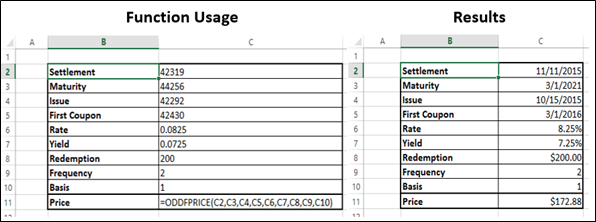
- Advanced Excel Functions Tutorial
- Advanced Excel Functions - Home
- Compatibility Functions
- Advanced Excel Functions - Cube
- Database Functions
- Date & Time Functions
- Engineering Functions
- Financial Functions
- Information Functions
- Advanced Excel Functions - Logical
- Lookup & Reference Functions
- Math & Trignometric Functions
- Statistical Functions
- Useful Resources
- Quick Guide
- Useful Resources
- Discussion
Financial - ODDFPRICE Function
Description
The ODDFPRICE function returns the price per $100 face value of a security having an odd (short or long) first period.
Syntax
ODDFPRICE (settlement, maturity, issue, first_coupon, rate, yld, redemption, frequency, [basis])
Arguments
| Argument | Description | Required/ Optional |
|---|---|---|
| Settlement | The security's settlement date. The security settlement date is the date after the issue date when the security is traded to the buyer. |
Required |
| Maturity | The security's maturity date. The maturity date is the date when the security expires. |
Required |
| Issue | The security's issue date. | Required |
| First_coupon | The security's first coupon date. | Required |
| Yld | The security's annual yield. | Required |
| Frequency | The number of coupon payments per year.
|
Required |
| Basis | The type of day count basis to use. Look at the Day Count Basis Table given below. |
Optional |
Day Count Basis Table
| Basis | Day Count Basis |
|---|---|
| 0 or omitted | US (NASD) 30/360 |
| 1 | Actual/actual |
| 2 | Actual/360 |
| 3 | Actual/365 |
| 4 | European 30/360 |
Notes
ODDFPRICE is calculated as follows −
Odd short first coupon −
$ODDFPRICE = \left [ \frac{redemption}{\left ( 1+\frac{yld}{frequency} \right )^{\left ( N-1+\frac{DSC}{E} \right )}} \right ]$
$+\left [ \frac{100 \times \frac{rate}{frequency} \times \frac{DFC}{E}}{\left ( 1+\frac{yld}{frequency} \right )^{\frac{DSC}{E}}} \right ]$
$+\left [\sum_{k=2}^{N} \frac{100 \times \frac{rate}{frequency}}{\left ( 1+\frac{yld}{frequency} \right )^{\left ( k-1+\frac{DSC}{E} \right )}} \right ]$
$-\left [ 100 \times \frac{rate}{frequency} \times \frac{A}{E}\right ]$
Where,
A = number of days from the beginning of the coupon period to the settlement date (accrued days).
DSC = number of days from the settlement to the next coupon date.
DFC = number of days from the beginning of the odd first coupon to the first coupon date.
E = number of days in the coupon period.
N = number of coupons payable between the settlement date and the redemption date. (If this number contains a fraction, it is raised to the next whole number.)
Odd long first coupon −
$ODDFPRICE = \left [ \frac{redemption}{\left ( 1+\frac{yld}{frequency} \right )^{\left ( N+N_g+\frac{DSC}{E} \right )}} \right ]$
$+\left [ \frac{100 \times \frac{rate}{frequency} \times \left [ \sum_{i=1}^{NC} \frac{DC_i}{NL_i} \right ]}{\left ( 1+\frac{yld}{frequency}\right )^{\left ( N_g+\frac{DSC}{E} \right )}} \right ]$
$+\left [\sum_{k=1}^{N} \frac{100 \times \frac{rate}{frequency}}{\left ( 1+\frac{yld}{frequency}\right )^{\left ( k-N_g+\frac{DSC}{E} \right )}} \right ]$
$-\left [ 100 \times \frac{rate}{frequency} \times \sum_{i=1}^{NC}\frac{A_i}{NL_i}\right ]$
Where,
Ai = number of days from the beginning of the ith, or last, quasi-coupon period within odd period.
DCi = number of days from dated date (or issue date) to first quasi-coupon (i = 1) or number of days in quasi-coupon (i = 2,..., i = NC).
DSC = number of days from settlement to next coupon date.
E = number of days in coupon period.
N = number of coupons payable between the first real coupon date and redemption date. (If this number contains a fraction, it is raised to the next whole number.)
NC = number of quasi-coupon periods that fit in odd period. (If this number contains a fraction, it is raised to the next whole number.)
NLi = normal length in days of the full ith, or last, quasi-coupon period within odd period.
Nq = number of whole quasi-coupon periods between settlement date and first coupon.
Dates should be entered by using the DATE Function, or as results of other formulas or functions. E.g. use DATE (2008,5,23) for the 23rd day of May, 2008. Problems can occur if dates are entered as text.
Microsoft Excel stores dates as sequential serial numbers so they can be used in calculations. By default, January 1, 1900 is serial number 1, and January 1, 2008 is serial number 39448 because it is 39,448 days after January 1, 1900.
The settlement date is the date a buyer purchases a coupon, such as a bond.
The maturity date is the date when a coupon expires.
For example, suppose a 30-year bond is issued on January 1, 2008, and is purchased by a buyer six months later, then −
the issue date would be January 1, 2008.
the settlement date would be July 1, 2008.
the maturity date would be January 1, 2038, which is 30 years after the January 1, 2008, issue date.
Settlement, maturity, issue, first_coupon, and basis are truncated to integers.
If settlement, maturity, issue, or first_coupon is not a valid Excel date, ODDFPRICE returns the #VALUE! error value.
If any of the specified arguments is non-numeric, ODDFPRICE returns the #VALUE! error value.
The following date condition must be satisfied. Otherwise, ODDFPRICE returns the #NUM! error value −
maturity ≥ first_coupon ≥ settlement ≥ issue
If rate < 0 or if yld < 0, ODDFPRICE returns the #NUM! error value.
If frequency is any number other than 1, 2, or 4, ODDFPRICE returns the #NUM! error value.
If basis < 0 or if basis > 4, ODDFPRICE returns the #NUM! error value.
Applicability
Excel 2007, Excel 2010, Excel 2013, Excel 2016
Example
